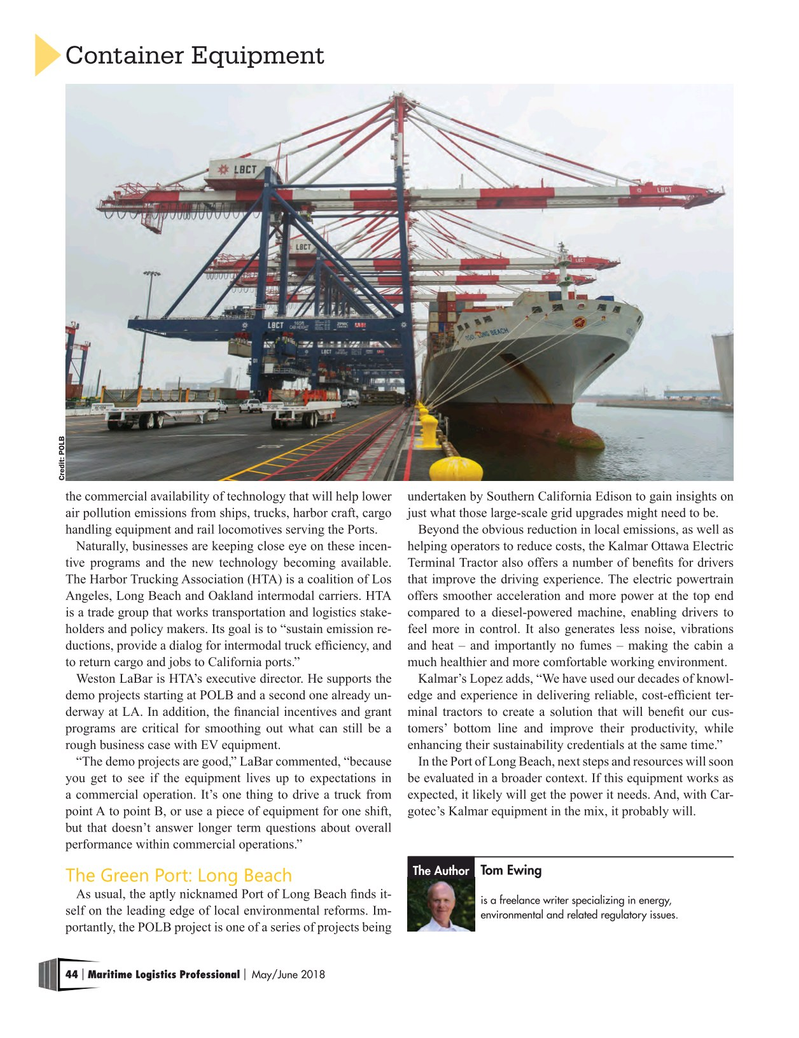
Page 44: of Maritime Logistics Professional Magazine (May/Jun 2018)
Container Ports
Read this page in Pdf, Flash or Html5 edition of May/Jun 2018 Maritime Logistics Professional Magazine
Container Equipment
Credit: POLB the commercial availability of technology that will help lower undertaken by Southern California Edison to gain insights on air pollution emissions from ships, trucks, harbor craft, cargo just what those large-scale grid upgrades might need to be. handling equipment and rail locomotives serving the Ports. Beyond the obvious reduction in local emissions, as well as
Naturally, businesses are keeping close eye on these incen- helping operators to reduce costs, the Kalmar Ottawa Electric tive programs and the new technology becoming available. Terminal Tractor also offers a number of benefts for drivers
The Harbor Trucking Association (HTA) is a coalition of Los that improve the driving experience. The electric powertrain
Angeles, Long Beach and Oakland intermodal carriers. HTA offers smoother acceleration and more power at the top end is a trade group that works transportation and logistics stake- compared to a diesel-powered machine, enabling drivers to holders and policy makers. Its goal is to “sustain emission re- feel more in control. It also generates less noise, vibrations ductions, provide a dialog for intermodal truck effciency, and and heat – and importantly no fumes – making the cabin a to return cargo and jobs to California ports.” much healthier and more comfortable working environment.
Weston LaBar is HTA’s executive director. He supports the Kalmar’s Lopez adds, “We have used our decades of knowl- demo projects starting at POLB and a second one already un- edge and experience in delivering reliable, cost-effcient ter- derway at LA. In addition, the fnancial incentives and grant minal tractors to create a solution that will beneft our cus- programs are critical for smoothing out what can still be a tomers’ bottom line and improve their productivity, while rough business case with EV equipment. enhancing their sustainability credentials at the same time.” “The demo projects are good,” LaBar commented, “because In the Port of Long Beach, next steps and resources will soon you get to see if the equipment lives up to expectations in be evaluated in a broader context. If this equipment works as a commercial operation. It’s one thing to drive a truck from expected, it likely will get the power it needs. And, with Car- point A to point B, or use a piece of equipment for one shift, gotec’s Kalmar equipment in the mix, it probably will.
but that doesn’t answer longer term questions about overall performance within commercial operations.”
Tom Ewing
The Author
The Green Port: Long Beach
As usual, the aptly nicknamed Port of Long Beach fnds it- is a freelance writer specializing in energy, self on the leading edge of local environmental reforms. Im- environmental and related regulatory issues.
portantly, the POLB project is one of a series of projects being 44 Maritime Logistics Professional May/June 2018 | |

 43
43

 45
45
